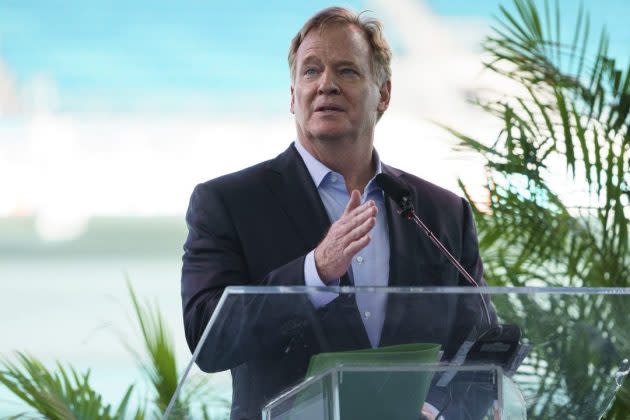Goodell’s $25 Billion Revenue Goal Remains in NFL’s 2027 Sights

It was the NFL’s annual March owners meeting in 2010 where commissioner Roger Goodell first presented an ambitious goal: $25 billion in yearly league revenue by 2027, up from roughly $8 billion at the time. It meant adding $1 billion in new revenue every year for nearly two decades. Last week, ahead of a thrilling Super Bowl that crowned the Los Angeles Rams as champions, Goodell was asked if the world’s richest sports league was on pace for that target.
“We don’t look at that number as the objective, honestly,” Goodell said at his annual pre-Super Bowl media address. “When we look at how we want the league to grow, we measure it in a lot of different ways. Most importantly, the fan base itself; how are we growing the game on a global basis? We expect to have close to 200 million fans here in the United States, but our real objective is how do we grow the game globally.”
More from Sportico.com
Sportico crunched the numbers and can answer the question more directly. Yes, the NFL is on track to hit $25 billion by 2027, up from roughly $18 billion in 2021.
The Rams’ Super Bowl win over the Bengals on Sunday capped a dramatic 2021 season that featured seven straight down-to-the-wire playoff games. TV ratings—already the envy of every non-NFL programming executive—soared even higher during the regular season, while the return of fans to stadiums meant nine-figure profits once again for many team owners, following a COVID-impacted 2020. The NFL gravy train is back in force. But it was chugging along even before the season started.
The biggest piece of the revenue question was put to bed last year when the NFL locked up its media deals for $113 billion over 11 years, with CBS, Fox, NBC, Disney and Amazon; the broadcast rights to Sunday Ticket are still to be determined.
The mega-pacts provided some clarity on what teams can expect from their annual distributions from the NFL. Teams received $309 million for 2020 and are expecting in the neighborhood of $335 million for 2021 from shared media, sponsorship and licensing deals. That will climb to roughly $400 million for 2023 under the new media contracts and is expected to approach $500 million per team by 2027, or roughly $16 billion in total.
During his press conference, Goodell pointed out how NFL content was more valuable than ever, based on the strong ratings for the 2021 season, which were up 9% overall during the regular season. He said the focus is how to share the game with more people and build on it. “The revenue follows that,” Goodell said.
Media is the NFL’s financial engine, but its sponsorship business continues to boom as well. Revenue rose 12% year-over-year to $1.8 billion, according to marketing firm IEG. League-level sponsorships fueled the gains, with a 23% increase versus 4% on the team level. Betting and gaming deals rose 140% and are now the second biggest sponsorship category—after technology—up from eighth last year, per IEG. Cybersecurity, spirits and specialty healthcare were other categories with big gains.
Total local team revenue, including shared gate receipts and non-NFL events, was roughly $7 billion in 2021 but should top $9 billion by 2027. Team sponsorships will get a boost from the NFL’s new home marketing area initiative, which awarded teams commercial exclusivity in markets outside the U.S. Teams will also be able to tap into gambling partnerships more deeply as legalized sports betting spreads across the country.
New stadiums are another potential revenue driver. The Buffalo Bills, Washington Commanders, née Football Team, and Carolina Panthers all want to replace their stadiums by 2027. The three currently play in venues that rank among the NFL’s nine oldest, but each of the other six have had renovations costing at least $200 million and more than $600 million in the case of the Chicago Bears. Goodell didn’t mince words in regards to the Bills’ facility. “The bottom line on it is we have to get a new stadium in Buffalo,” he said.
The NFL is losing one of its biggest box office draws with the retirement of Tom Brady, but there is a crop of young stars poised to fill the void. Brady was the only player older than 28 who ranked among the NFL’s Top 10 in merchandise sales last year. Add in a labor deal that runs through 2030, and corporate advertisers will continue to gravitate to the NFL knowing it’s the best way to consistently reach the biggest audience.
